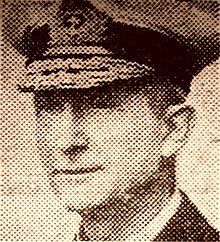Sir George Egerton | |
|---|---|
 Sir George Egerton, 1916 | |
| Born | 17 October 1852 |
| Died | 30 March 1940 (aged 87) |
| Allegiance |
|
| Service/ |
|
| Years of service | 1866 – 1916 |
| Rank | Admiral |
| Unit | Royal Navy |
| Commands held |
HMS Majestic Cape of Good Hope Station Plymouth Command |
| Battles/wars | World War I |
| Awards | Knight Commander of the Order of the Bath |
Admiral Sir George Le Clerc Egerton KCB (17 October 1852 – 30 March 1940) was a senior Royal Navy officer from the Egerton family who rose to become Second Sea Lord.
Egerton joined the Royal Navy in 1866. [1] He served on the Arctic Expedition of 1875–76. [1] In 1893 he was promoted to captain and appointed a naval attaché before serving with the Naval Brigade in Mombasa in 1895, [1] and he was chief of staff for the Benin Expedition of 1897. [1]
By early 1900 he was in command of the pre-dreadnought battleship HMS Majestic, serving as flagship to Vice-Admiral Sir Harry Rawson, commander-in-chief of the Channel Fleet. [2] In June 1901 he was transferred to the President for service as assistant director of torpedoes at the Admiralty, [3] a position he left the following February when he transferred to the torpedo school ship Vernon. [4]
He was appointed second-in-command of the Atlantic Fleet in 1906: [1] Egerton flew his flag on HMS Victorious, with Captain Robert Scott as his flag captain. [5] He became commander-in-chief, Cape of Good Hope Station in 1908 and Second Sea Lord in 1911. [1] He served in World War I as Commander-in-Chief, Plymouth. [1] He had previously served as aide-de-camp to King Edward VII, and retired in 1916. [1]
A grandson of The Rev Sir Philip Grey-Egerton, 9th Bt, he married, first, in 1882, Frances Emily Gladstone; they had two sons and a daughter, including Rear-Admiral Brian Egerton (1886–1973). He married, second, Margaret Stella Maunsell, in 1932. [6]
- ^ a b c d e f g h Sir George Le Clerc Egerton Liddell Hart Centre for Military Archives
- ^ "Naval & Military intelligence". The Times. No. 36054. London. 1 February 1900. p. 6.
- ^ "Naval & Military intelligence". The Times. No. 36468. London. 30 May 1901. p. 4.
- ^ "Naval & Military intelligence". The Times. No. 36666. London. 16 January 1902. p. 7.
- ^ Preston, Diana: A First Rate Tragedy: Captain Scott's Antarctic Expeditions Constable (pb edition), page 86, London, 1999 ISBN 0-09-479530-4 OCLC 59395617
- ^ The Peerage.com
![]() Media related to
George Egerton (Royal Navy officer) at Wikimedia Commons
Media related to
George Egerton (Royal Navy officer) at Wikimedia Commons
- The Dreadnought Project: George Egerton
Sir George Egerton | |
|---|---|
 Sir George Egerton, 1916 | |
| Born | 17 October 1852 |
| Died | 30 March 1940 (aged 87) |
| Allegiance |
|
| Service/ |
|
| Years of service | 1866 – 1916 |
| Rank | Admiral |
| Unit | Royal Navy |
| Commands held |
HMS Majestic Cape of Good Hope Station Plymouth Command |
| Battles/wars | World War I |
| Awards | Knight Commander of the Order of the Bath |
Admiral Sir George Le Clerc Egerton KCB (17 October 1852 – 30 March 1940) was a senior Royal Navy officer from the Egerton family who rose to become Second Sea Lord.
Egerton joined the Royal Navy in 1866. [1] He served on the Arctic Expedition of 1875–76. [1] In 1893 he was promoted to captain and appointed a naval attaché before serving with the Naval Brigade in Mombasa in 1895, [1] and he was chief of staff for the Benin Expedition of 1897. [1]
By early 1900 he was in command of the pre-dreadnought battleship HMS Majestic, serving as flagship to Vice-Admiral Sir Harry Rawson, commander-in-chief of the Channel Fleet. [2] In June 1901 he was transferred to the President for service as assistant director of torpedoes at the Admiralty, [3] a position he left the following February when he transferred to the torpedo school ship Vernon. [4]
He was appointed second-in-command of the Atlantic Fleet in 1906: [1] Egerton flew his flag on HMS Victorious, with Captain Robert Scott as his flag captain. [5] He became commander-in-chief, Cape of Good Hope Station in 1908 and Second Sea Lord in 1911. [1] He served in World War I as Commander-in-Chief, Plymouth. [1] He had previously served as aide-de-camp to King Edward VII, and retired in 1916. [1]
A grandson of The Rev Sir Philip Grey-Egerton, 9th Bt, he married, first, in 1882, Frances Emily Gladstone; they had two sons and a daughter, including Rear-Admiral Brian Egerton (1886–1973). He married, second, Margaret Stella Maunsell, in 1932. [6]
- ^ a b c d e f g h Sir George Le Clerc Egerton Liddell Hart Centre for Military Archives
- ^ "Naval & Military intelligence". The Times. No. 36054. London. 1 February 1900. p. 6.
- ^ "Naval & Military intelligence". The Times. No. 36468. London. 30 May 1901. p. 4.
- ^ "Naval & Military intelligence". The Times. No. 36666. London. 16 January 1902. p. 7.
- ^ Preston, Diana: A First Rate Tragedy: Captain Scott's Antarctic Expeditions Constable (pb edition), page 86, London, 1999 ISBN 0-09-479530-4 OCLC 59395617
- ^ The Peerage.com
![]() Media related to
George Egerton (Royal Navy officer) at Wikimedia Commons
Media related to
George Egerton (Royal Navy officer) at Wikimedia Commons
- The Dreadnought Project: George Egerton